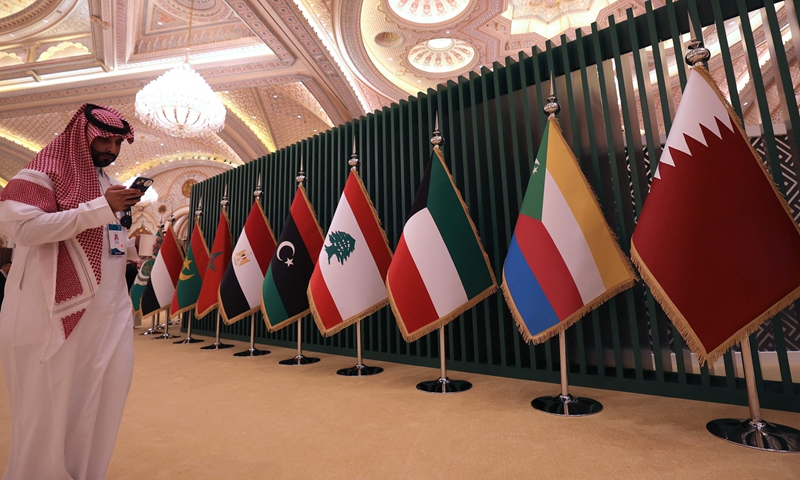
A man stands near national flags during the 10th Arab-China Business Conference in Riyadh, Saudi Arabia, on June 11, 2023. Photo: VCG
The 10th Arab-China Business Conference, which is said to be the largest business gathering between China and Arab countries, kicked off on Sunday in Riyadh, Saudi Arabia, where cooperation between China and Arab countries are expected to be further strengthened.
The conference is being held under the theme "Collaborating For Prosperity" with the aim of supporting and promoting cooperation in areas such as the economy, trade and investment to achieve solutions of common interest for both Arab nations and China through strategic collaboration, according to the website of the conference.
About 3,000 participants, including more than 150 speakers, including government officials, investors and business leaders from 16 industry sectors are attending.
The agenda includes sessions and discussions that range from investment in the China-proposed Belt and Road Initiative (BRI), clean energy cooperation and the oil and gas supply chain, to tourism and entertainment sectors as well as financing and investment opportunities in the capital markets.
The conference comes after the success of the first China-Arab States Summit at the end of 2022, which injected fresh impetus into the development of China-Arab relations and practical cooperation across the board.
In 2022, trade between China and Arab countries exceeded $430 billion. Under the BRI framework, the two sides have had robust cooperation, which has boosted their development and rejuvenation, according to China's Ministry of Foreign Affairs.
With the rapid development of China's economy and increasing market demand, Arab countries have become important energy suppliers and trading partners of China, and bilateral economic cooperation has ushered in a historic opportunity, Hong Yong, a research fellow with the Chinese Academy of International Trade and Economic Cooperation, told the Global Times on Sunday.
"The two sides are expected to further strengthen inter-governmental communication and cooperation this year, focusing on cooperation in infrastructure, energy, finance and information technology, and seeking broader and deeper cooperation opportunities," Hong said.
Closers China-Arab cooperation also comes as Saudi Arabia, the world's top crude exporter and largest Arab economy, aims to cut oil dependence with new industries under its economic agenda - Vision 2030.
Lin Boqiang, director of the China Center for Energy Economics Research at Xiamen University, said that China can play a crucial role in Saudi Arabia's transition from traditional energy sources to a low-carbon economy based on complementary needs.
Saudi Arabia shipped 87.49 million tons of crude to China in 2022, equivalent to 1.75 million barrels per day, according to data from Chinese customs.
"It is expected that Saudi Arabia will remain the top crude oil supplier to China in 2023," Lin said.
In terms of renewable energy, China can offer more advanced photovoltaic equipment to the country to develop its solar energy resources, Li said, noting that China's overall photovoltaic industry chains are most competitive in the world.
In recent years, China and Saudi Arabia have made rapid progress in strengthening energy cooperation.
In March, Saudi Aramco signed definitive agreements to acquire a 10 percent interest in Shenzhen-listed Rongsheng Petrochemical Co, in a bid to significantly expand its presence in China and secure a reliable supply of essential crude to one of China's most important refiners.
It was followed with an agreement among Aramco, Baosteel and the Public Investment Fund (PIF) in May to establish an integrated steel plate manufacturing complex in Saudi Arabia. The facility is expected to have a steel plate production capacity of up to 1.5 million tons per year and aims to reduce CO2 emissions from the steel-making process by up to 60 percent.




